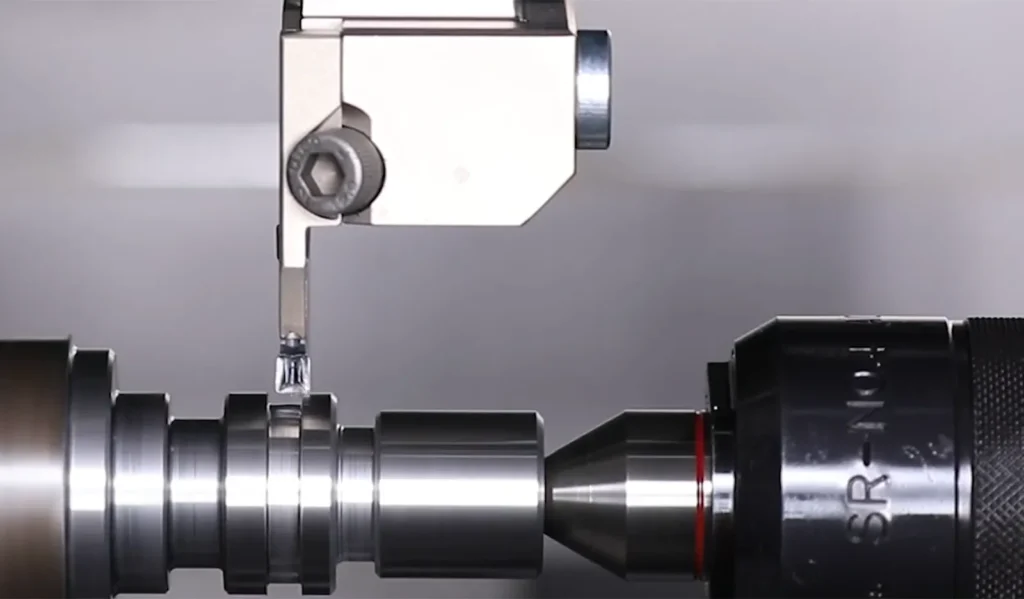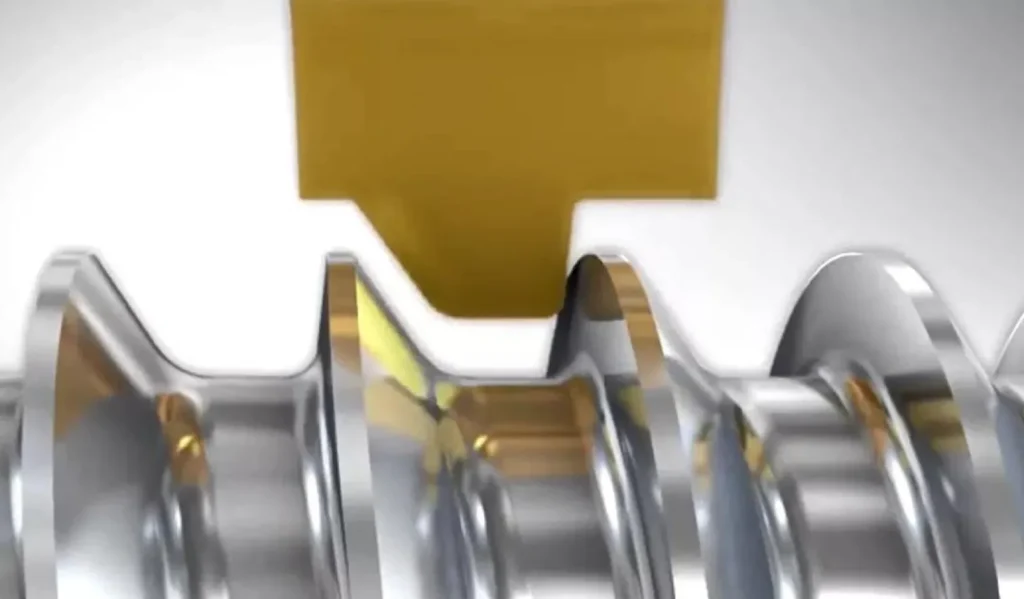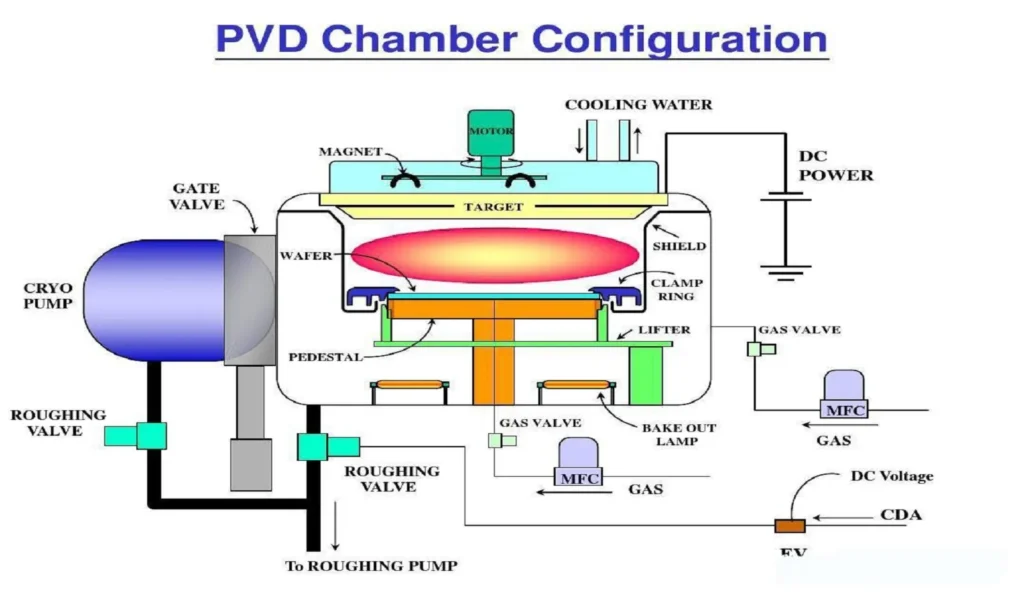금속 가공 및 CNC 가공 분야에서 그루브 인서트는 정밀하고 효율적인 결과를 얻는 데 중요한 역할을 합니다. 이 다용도 절삭 공구는 공작물에 홈, 슬롯 및 기타 복잡한 특징을 만드는 데 없어서는 안 될 필수품입니다. 숙련된 기공사이든 이 분야를 처음 접하는 사람이든, 다양한 가공 작업을 마스터하려면 홈 가공 인서트에 대한 이해가 필수적입니다. 이 포괄적인 가이드에서는 가공 공정을 최적화하는 데 도움이 되는 그루브 인서트의 유형, 응용 분야 및 모범 사례를 살펴보면서 복잡한 그루브 인서트에 대해 자세히 설명합니다.

그루브 인서트는 무엇인가요?
그루브 인서트는 공작물에 홈, 채널 또는 홈을 만들도록 설계된 특수 절삭 공구입니다. 이러한 인서트는 일반적으로 카바이드, 세라믹 또는 다결정 다이아몬드(PCD)와 같은 단단하고 내마모성이 강한 재료로 만들어집니다. 그루브 인서트는 선삭, 밀링, 나사 가공 등 다양한 가공 작업에 사용되어 정밀하고 일관된 그루브 프로파일을 생성합니다.
그루브 인서트의 설계는 절삭 효율, 칩 제어 및 공구 수명의 균형을 맞추기 위해 세심하게 설계되었습니다. 대부분의 그루브 인서트는 단일 절삭날을 사용하여 그루브 폭과 깊이를 정밀하게 제어할 수 있습니다. 절삭날의 형상은 절삭력을 줄이고 칩 배출을 개선하여 깨끗하고 정확한 그루브 프로파일을 보장하도록 최적화되어 있습니다.
그루브 인서트의 종류
그루브 인서트의 세계는 특정 가공 요구 사항을 충족하도록 설계된 다양한 유형으로 다양합니다. 주요 카테고리를 자세히 살펴보겠습니다:
1. CNC 그루브 인서트
CNC 그루브 인서트는 컴퓨터 수치 제어(CNC) 기계에 사용하도록 특별히 설계되었습니다. 이 인서트는 높은 정밀도와 반복성을 제공하므로 대규모 생산 환경에 이상적입니다. CNC 그루브 인서트는 다양한 홈 프로파일과 가공 매개변수를 수용할 수 있도록 다양한 모양과 크기로 제공됩니다.
CNC 그루브 인서트의 주요 기능은 다음과 같습니다:
- 일관된 결과를 위한 정밀한 치수 공차
- 향상된 칩 제어를 위한 고급 칩 브레이커 설계
- 고속 가공 작업과의 호환성
- 절삭력 감소 및 공구 수명 향상을 위한 최적화된 지오메트리
적용 예시: 자동차 산업에서 CNC 그루브 인서트는 엔진 블록의 피스톤 링을 위한 정밀한 홈을 만들어 최적의 밀봉과 성능을 보장하는 데 사용될 수 있습니다.
2. PCD 그루브 인서트
다결정 다이아몬드(PCD) 그루브 인서트는 탁월한 경도와 내마모성으로 잘 알려진 프리미엄 절삭 공구입니다. 이 인서트는 알루미늄 합금, 복합재 및 비철금속과 같은 연마성 소재를 가공할 때 특히 효과적입니다. PCD 그루브 인서트는 공구 수명이 연장되고 표면 정삭 품질이 우수합니다.
PCD 그루브 인서트의 장점은 다음과 같습니다:
- 극한의 경도 및 내마모성
- 뛰어난 열 전도성으로 열 방출
- 장시간 날카로운 절삭날을 유지할 수 있는 기능
- 비철 부품의 대량 생산에 이상적
적용 예시: 항공우주 산업에서는 정밀도와 표면 품질이 중요한 알루미늄 항공기 부품의 홈 가공에 PCD 그루브 인서트를 사용할 수 있습니다.
3. 페이스 그루브 인서트
페이스 그루브 인서트는 공작물의 페이스 또는 끝 부분에 홈을 만들기 위해 설계되었습니다. 이 인서트는 일반적으로 원형 홈, O링 시트 및 기타 방사형 피처를 생성하기 위해 선삭 가공에 사용됩니다. 페이스 그루브 인서트는 칩 배출을 보장하고 절삭력을 최소화하기 위해 특수한 형상을 갖는 경우가 많습니다.
페이스 그루브 인서트의 주요 특징:
- 방사형 절삭력을 견디는 견고한 설계
- 효율적인 칩 제거를 위한 특수 칩 브레이커
- 다양한 홈 크기를 수용할 수 있도록 다양한 폭으로 제공됩니다.
- 중립 또는 플러스 레이크 각도로 부드러운 커팅 동작이 가능한 경우가 많습니다.
적용 예시: 유압 산업에서 페이스 그루브 인서트는 원통형 부품의 끝 부분에 정밀한 오링 그루브를 만들어 고압 시스템에서 적절한 밀봉을 보장하는 데 사용할 수 있습니다.
4. 더브테일 페이스 그루브 인서트
더브테일 페이스 그루브 인서트 은 도브테일 모양의 홈을 만드는 데 사용되는 특수한 유형의 페이스 그루브 도구입니다. 이 홈은 개구부보다 베이스가 넓어 O링이나 씰과 같은 부품에 탁월한 기계적 잠금을 제공합니다. 도브테일 페이스 그루브 인서트는 원하는 프로파일을 얻기 위해 정밀한 위치 지정과 절단 파라미터가 필요합니다.
도브테일 페이스 그루브 인서트의 고유한 특징:
- 더브테일 모양을 생성하는 복잡한 최첨단 기하학적 구조
- 올바른 방향을 위해 특수 도구 홀더 필요
- 전문 프로그래밍 기법과 함께 사용되는 경우가 많습니다.
- 다양한 도브테일 사양에 맞게 다양한 각도로 사용 가능
적용 예시: 산업용 밸브 생산에서 도브테일 페이스 그루브 인서트는 특수 씰을 위한 안전한 시팅을 생성하여 고압에서 누출 없이 작동하도록 보장하는 데 사용할 수 있습니다.
5. 전체 반경 그루브 인서트
전체 반경 그루브 인서트는 부드러운 곡선형 홈 프로파일을 생성하는 둥근 절삭 날을 특징으로 합니다. 이 인서트는 응력 완화 또는 유체 흐름 개선이 필요한 응용 분야에 이상적입니다. 전체 반경 그루브 인서트는 자동차, 항공우주 및 유압 산업에서 일반적으로 사용됩니다.
전체 반경 그루브 인서트의 장점:
- 매끄럽고 스트레스 없는 그루브 프로파일 생성
- 유압 및 공압 시스템의 유체 역학 개선
- 고응력 부품의 균열 발생 위험 감소
- 모서리가 날카로운 그루브에 비해 표면 마감이 개선되는 경우가 많습니다.
적용 예시: 터빈 부품 설계에서 전체 반경 그루브 인서트를 사용하여 냉각 유체 흐름을 위한 원활한 채널을 만들어 열 방출과 엔진 효율을 최적화할 수 있습니다.
6. 폴리 V 그루브 인서트
폴리 V 그루브 인서트 는 여러 개의 V자 홈을 동시에 만들 수 있도록 설계된 특수 절삭 공구로, 일반적으로 폴리 V벨트 및 풀리 생산에 사용됩니다. 이러한 인서트는 벨트를 통한 동력 전달이 필요한 자동차 및 산업용 애플리케이션에서 매우 중요합니다.
폴리 V 그루브 인서트의 주요 특징은 다음과 같습니다:
- V자 패턴으로 배열된 여러 개의 절삭날
- 정확한 그루브 형상을 보장하는 정밀 연삭 프로파일
- 다양한 폴리 V-벨트 사양에 맞게 다양한 표준 크기로 제공됩니다.
- 공구 수명 연장을 위해 고성능 초경 재종으로 제작되는 경우가 많습니다.
폴리 V 그루브 인서트 사용의 장점:
- 한 번의 패스로 여러 그루브를 가공하여 생산성 향상
- 전체 풀리 표면에서 일관된 홈 간격 및 깊이 유지
- 순차적 단일 그루브 작업에 비해 향상된 표면 마감 처리
- 가공 시간 및 공구 교환 시간 단축
적용 예시: 자동차 산업에서 폴리 V 그루브 인서트는 엔진 액세서리 드라이브용 뱀형 벨트 풀리를 제조하는 데 사용되어 벨트의 정밀한 맞춤과 최적의 동력 전달을 보장합니다.
폴리 V 그루브 인서트를 선택할 때는 다음 요소를 고려하세요:
- 필요한 그루브 수
- 그루브 피치 및 프로파일 사양
- 공작물 재질(일반적으로 풀리의 경우 알루미늄 또는 강철)
- 기계 강성 및 전력 성능
폴리 V 그루브 인서트의 올바른 사용에는 주의가 필요합니다:
- 공구 홀더의 정확한 인서트 정렬
- 여러 절삭 날의 열 발생을 관리하기 위한 적절한 냉각수 공급
- 생산성과 공구 수명의 균형을 맞추기 위한 절삭 파라미터의 세심한 제어
가공 작업에 폴리 V 그루브 인서트를 통합하면 풀리 생산의 효율성과 품질을 크게 개선하여 다양한 응용 분야에서 더 나은 성능의 동력 전달 시스템을 구축할 수 있습니다.
그루브 인서트 명명법
그루브 인서트 명명법을 이해하는 것은 용도에 맞는 공구를 선택하는 데 매우 중요합니다. 명명 규칙에는 일반적으로 인서트의 모양, 크기, 이격 각도 및 기타 특성에 대한 정보가 포함됩니다. 일반적인 그루브 인서트 이름을 분석해 보겠습니다:
MGMN 200-G
- M: 삽입 모양(이 경우 마름모)
- G: 클리어런스 각도
- M: 허용 오차 등급
- N: 최첨단 상태
- 200: 삽입 크기(예: 2mm 두께)
- G: 칩 브레이커 지정
추가로 발생할 수 있는 명명법 요소는 다음과 같습니다:
- 코팅 유형(예: TiN, AlTiN)
- 등급(인서트의 구성과 용도를 나타내는 등급)
- 특수 지오메트리 표시기(예: 와이퍼 플랫, 혼 디자인)
이러한 코드를 숙지하면 특정 가공 요구에 적합한 그루브 인서트를 신속하게 식별하고 선택하는 데 도움이 됩니다. 또한 툴링 회사마다 명명법에 약간의 차이가 있을 수 있으므로 제조업체 카탈로그를 참조하는 것이 중요합니다.
그루브 인서트의 적용 분야
그루브 인서트는 다양한 산업 분야의 광범위한 가공 응용 분야에 사용됩니다. 몇 가지 일반적인 응용 분야는 다음과 같습니다:
- O링 그루브 및 씰 시트 만들기
- 예시: 유압 실린더 엔드 캡의 정밀한 홈 가공을 통한 적절한 밀봉 보장
- 스냅 링 그루브 제작
- 예시: 안전한 조립을 위해 자동차 변속기 부품에 고정 링 홈 만들기
- 언더컷 및 오목 가공
- 예시: 샤프트 칼라에 릴리프 홈을 형성하여 응력 집중을 줄임
- 선삭 작업에서 나사산 형성
- 예시: 특수 그루브 인서트를 사용하여 고정밀 패스너에 맞춤형 나사산 프로파일 생성
- 고리 고정용 슬롯 만들기
- 예시: 베어링 고정을 위한 서클립을 수용하기 위한 모터 샤프트의 가공 홈 가공
- 유압 부품의 유체 통과를 위한 홈 제작
- 예시: 유압 시스템에서 오일 흐름을 제어하기 위해 밸브 본체에 채널 만들기
- 키홈 및 스플라인 가공용 홈 가공
- 예시: 동력 전달 애플리케이션을 위한 드라이브 샤프트의 키홈 슬롯 형성
그루브 인서트의 다용도성 덕분에 자동차, 항공우주, 석유 및 가스, 일반 제조 등의 산업에서 필수적인 도구로 사용되고 있습니다. 제조업체는 적절한 그루브 인서트를 선택하고 가공 파라미터를 최적화함으로써 다양한 재료와 부품 형상에 걸쳐 고정밀 결과를 얻을 수 있습니다.
그루브 가공과 스레딩: 차이점 이해
홈 가공과 스레딩 작업은 비슷해 보이지만 서로 다른 용도로 사용되며 별도의 툴이 필요합니다:
그루빙:
- 직사각형 또는 곡선형 프로파일로 공작물에 채널 또는 홈을 만듭니다.
- 그루브 인서트는 일반적으로 평평하거나 약간 구부러진 절삭 날이 있습니다.
- 공구가 일정한 깊이를 유지하면서 공작물 내부로 방사형으로 이동합니다.
- 주로 O링 그루브, 언더컷, 페이스 그루브와 같은 피처를 만드는 데 사용됩니다.
- 홈 너비는 인서트 너비에 따라 결정됩니다.
스레딩:
- 원통형 표면에 나선형 융기(외부 나사산) 또는 홈(내부 나사산)을 생성합니다.
- 스레딩 인서트에는 특정 스레드 프로파일을 생성하도록 설계된 뾰족하거나 각진 절삭 날이 있습니다.
- 공구가 나선형 경로를 따라 점차적으로 공작물 깊숙이 절삭합니다.
- 볼트, 너트, 나사 연결과 같은 고정 기능을 만드는 데 사용됩니다.
- 나사산 프로파일은 인서트 형상과 나선형 공구 경로에 따라 결정됩니다.
가장 큰 차이점은 공구 이동과 결과물에 있습니다. 홈 가공은 공구를 공작물에 방사형으로 밀어 넣는 반면, 나사 가공은 나선형 공구 경로를 통해 연속적인 나선형 나사 형태를 만들어야 합니다.
비교 예시:
- 그루브 작업: 샤프트에 폭 5mm, 깊이 2mm의 O링용 홈 만들기
- 스레딩 작업: 너트 부착을 위해 동일한 샤프트에 M10x1.5 외부 나사산 제작
그루브 대 이별: 주요 차이점
그루브 가공과 이별 가공은 서로 연관된 작업이지만 서로 다른 용도로 사용되며 뚜렷한 특징이 있습니다:
그루빙:
- 공작물을 두 조각으로 분리하지 않고 공작물에 채널 또는 홈을 만듭니다.
- 홈의 깊이는 일반적으로 공작물 반경보다 작습니다.
- 정밀도와 표면 마감을 위해 설계된 더 좁은 인서트 사용
- 더 깊은 홈을 위해 여러 번의 패스가 필요한 경우가 많습니다.
- 주요 목표는 특정 기능 또는 프로필을 만드는 것입니다.
이별:
- 전체 공작물을 절단하여 두 개의 별개의 부분으로 분리하는 작업이 포함됩니다.
- 절삭 깊이가 공작물 반경과 같거나 초과합니다.
- 더 높은 절삭력을 견딜 수 있도록 설계된 더 넓고 견고한 인서트를 사용합니다.
- 일반적으로 공작물을 완전히 절단하기 위해 한 번의 패스로 수행됩니다.
- 주요 목표는 공작물의 섹션을 분리하거나 제거하는 것입니다.
두 작업 모두 유사한 공구 형상을 사용하지만, 일반적으로 절삭 공구는 공작물의 완전한 분리를 처리하는 데 더 견고합니다. 심부 절삭 작업의 어려움을 관리하기 위해 특수 칩 브레이커와 절삭유 공급 시스템을 갖춘 경우가 많습니다.
비교 예시:
- 그루브 작업: 직경 50mm 샤프트에 폭 3mm, 깊이 5mm의 원형 홈 만들기
- 절단 작업: 동일한 직경 50mm 샤프트의 끝에서 10mm 길이의 섹션을 잘라냅니다.
올바른 그루브 인서트 선택
최적의 결과를 얻으려면 적절한 그루브 인서트를 선택하는 것이 중요합니다. 그루브 인서트를 선택할 때는 다음 요소를 고려하세요:
- 공작물 소재: 인서트 등급을 가공 중인 소재와 일치시킵니다.
- 예를 들어 강철에는 코팅된 카바이드 인서트를, 알루미늄 합금에는 PCD 인서트를 사용합니다.
- 홈 치수: 원하는 홈 폭에 해당하는 삽입 너비를 선택합니다.
- 필요한 경우 더 넓은 홈을 위해 더 좁은 인서트로 여러 패스를 사용하는 것이 좋습니다.
- 절단 조건: 절단 속도, 이송 속도, 절단 깊이와 같은 요소를 고려합니다.
- 속도가 빠를수록 내마모성 등급 또는 코팅이 더 필요할 수 있습니다.
- 기계 안정성: 설정의 강성을 평가하고 예상되는 진동을 처리할 수 있는 인서트를 선택합니다.
- 덜 견고한 설정의 경우, 절삭력을 줄이기 위해 양의 레이크 각도를 가진 인서트를 고려하십시오.
- 표면 마감 요구 사항: 원하는 마감 품질에 맞는 적절한 칩 브레이커와 가장자리 준비가 된 인서트를 선택합니다.
- 와이퍼 형상은 특정 애플리케이션에서 더 나은 표면 마감을 달성하는 데 도움이 될 수 있습니다.
- 기대되는 공구 수명: 인서트의 내마모성과 교체 빈도를 고려하여 성능과 비용의 균형을 맞출 수 있습니다.
- 프리미엄 등급 또는 코팅은 초기 비용이 더 높을 수 있지만 대량 생산 시에는 더 경제적일 수 있습니다.
- 절삭유 가용성: 절삭유 공급 방법(플러드, 고압 또는 건식 가공)에 따라 적절한 칩 브레이커 및 코팅이 적용된 인서트를 선택합니다.
- 특수 형상: 스위스형 가공 또는 고강도 그루브 가공과 같은 특수한 용도를 위한 특수 인서트 디자인을 고려하세요.
이러한 요소를 신중하게 평가하고 툴링 제조업체 또는 숙련된 기계 기술자와 상담하여 특정 응용 분야에 맞는 최적의 그루브 인서트를 선택하면 효율적이고 고품질의 결과를 보장할 수 있습니다.
그루브 인서트 사용 모범 사례
그루브 인서트의 성능과 수명을 극대화하려면 다음 모범 사례를 따르세요:
- 도구 홀더에 인서트가 올바르게 장착되고 고정되었는지 확인합니다.
- 설치하기 전에 인서트 포켓과 클램핑 표면을 청소하세요.
- 토크 렌치를 사용하여 올바른 체결력을 적용하세요.
- 인서트 제조업체에서 제공하는 권장 절단 매개변수를 사용합니다.
- 보수적인 속도와 피드로 시작한 다음 결과에 따라 최적화하기
- 툴링 회사에서 제공하는 절삭 파라미터 계산기 또는 앱을 사용하는 것이 좋습니다.
- 적절한 냉각수 흐름을 유지하여 열 발생과 칩 배출을 관리합니다.
- 칩 제어 향상을 위해 가능하면 고압 냉각수를 사용하세요.
- 절삭유 노즐이 절단 영역에 올바르게 정렬되었는지 확인합니다.
- 인서트 마모를 모니터링하고 과도하게 마모되기 전에 인서트를 교체하세요.
- 생산 요구 사항에 따라 정기적인 검사 일정을 수립하세요.
- 측면 마모, 크레이터 마모 또는 가장자리 칩핑과 같은 마모 징후를 확인합니다.
- 가공 전략을 최적화하여 공구 처짐과 진동을 최소화하세요.
- 가능한 가장 짧은 도구 오버행을 사용하여 강성을 극대화합니다.
- 깊은 홈 가공 작업에는 진동 방지 보링 바 사용을 고려하세요.
- 특정 소재의 인서트 성능을 향상시키기 위해 특수 코팅을 사용하는 것을 고려하세요.
- 예를 들어 고온 응용 분야를 위한 AlTiN 코팅이나 비철 소재를 위한 다이아몬드 코팅이 있습니다.
- 일관된 성능을 보장하기 위해 정기적으로 툴을 청소하고 유지 관리하세요.
- 인서트 및 공구 홀더에서 빌트업 에지(BUE) 및 칩 축적물 제거
- 공구 홀더 또는 클램핑 메커니즘의 손상 여부를 확인합니다.
- 다양한 칩 브레이커 설계로 실험하여 칩 제어를 최적화하세요.
- 적절한 칩 형성 및 배출은 그루브 품질과 공구 수명에 매우 중요합니다.
- CAM 소프트웨어를 사용하여 그루브 가공 공구 경로를 시뮬레이션하고 최적화합니다.
- 이를 통해 실제 가공 전에 잠재적인 문제를 파악하고 전반적인 효율성을 개선할 수 있습니다.
- 인서트 성능과 마모 패턴에 대한 자세한 기록을 보관하세요.
- 이 데이터는 향후 툴링 선택 및 프로세스 개선에 도움이 될 수 있습니다.
이러한 모범 사례를 구현하면 그루브 작업의 성능, 일관성 및 비용 효율성을 크게 개선할 수 있습니다.
결론
그루브 인서트는 정밀 가공 분야에서 없어서는 안 될 도구입니다. 기공사는 그루브 인서트와 관련된 다양한 유형, 응용 분야 및 모범 사례를 이해함으로써 생산성 향상, 부품 품질 개선 및 제조 비용 절감을 달성할 수 있습니다. CNC 그루브 인서트, PCD 그루브 인서트 또는 도브테일 페이스 그루브 인서트와 같은 특수 변형 제품을 사용하든, 이러한 다용도 절삭 공구의 사용법을 숙지하면 가공 능력을 향상시킬 수 있습니다.
기술이 계속 발전함에 따라 그루브 인서트 디자인과 소재는 현대 제조의 끊임없이 증가하는 요구 사항을 충족하기 위해 진화할 것입니다. 인서트 형상, 코팅 및 재종의 혁신은 성능을 개선하고 공구 수명을 연장하며 가공 가능한 재료의 범위를 확장하기 위해 지속적으로 개발되고 있습니다. 그루브 인서트 기술에서 새롭게 떠오르는 몇 가지 트렌드는 다음과 같습니다:
- 향상된 내마모성 및 칩 배출을 위한 고급 PVD 및 CVD 코팅
- 의료 기기 제조와 같은 산업 분야의 초정밀 애플리케이션을 위한 마이크로 그루브 인서트
- 실시간 공구 마모 모니터링 및 예측 유지보수를 위한 센서 통합
- 인성 및 열 안정성 향상을 위한 새로운 기판 소재 개발
- 맞춤형 인서트 형상 제작을 위한 적층 제조 기술
그루브 인서트 기술의 최신 개발에 대한 정보를 얻고 가공 공정을 지속적으로 개선하면 가장 까다로운 가공 작업도 자신감 있고 정밀하게 처리할 수 있습니다. 성공적인 그루브 가공을 위해서는 인서트 자체뿐만 아니라 공작 기계, 공작물 소재, 절삭 조건 등 전체 가공 시스템을 고려한 총체적인 접근 방식이 필요하다는 점을 기억하세요. 올바른 지식, 공구 및 기술을 사용하면 그루브 인서트의 잠재력을 최대한 발휘하고 가공 능력을 새로운 차원으로 끌어올릴 수 있습니다.


